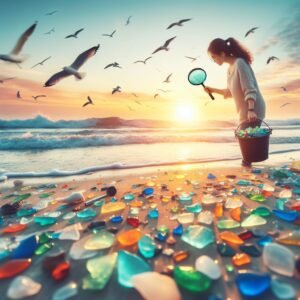Introduction
Are you drawn to the mesmerizing allure of sea glass, those beautifully weathered shards of glass washed ashore by the ebb and flow of the ocean? If so, you’re not alone. Sea glass hunting has captivated beachcombers and treasure hunters for generations, offering a unique blend of adventure, relaxation, and environmental stewardship.
In this comprehensive guide, we’ll delve into the world of sea glass and unveil the top beaches in the UK where you can embark on your sea glass treasure hunt. From the rugged shores of Cornwall to the sandy expanses of Scotland, the UK boasts an array of beaches teeming with sea glass waiting to be discovered.
So grab your sunscreen, a sturdy pair of shoes, and a keen eye for spotting hidden gems as we explore the enchanting world of sea glass treasures along the shores of the United Kingdom.
What is Sea Glass?
Before we dive into our exploration of the UK’s top sea glass beaches, let’s take a moment to understand what exactly sea glass is and how it comes to be.
Definition and Origin
Sea glass, also known as beach glass or mermaid’s tears, is glass that has been tumbled and weathered by the sea, transforming it into smooth, frosted gems. This glass typically originates from discarded bottles, jars, and other glassware that find their way into the ocean.
Over time, the glass is buffeted by the waves, worn down by the sand and rocks, and exposed to the elements, resulting in its signature smooth and frosty appearance.

Colors and Types
Sea glass comes in a variety of colors, ranging from soft pastels to vibrant hues. The most common colors include seafoam green, cobalt blue, and amber brown, though rarer shades such as red and orange are prized finds among collectors.
The type of glass and its color are influenced by factors such as the source material, the length of time it has been in the ocean, and the conditions of the beach where it is found.
Popular Uses
While sea glass may have started its journey as discarded waste, it has since been transformed into a coveted treasure sought after by collectors, artisans, and jewelry makers alike.
- Crafts and Jewelry: Sea glass is often used to create stunning jewelry pieces, including earrings, pendants, and bracelets. Its smooth texture and vibrant colors make it a favorite material for crafting unique and eco-friendly accessories.
- Home Decor: Beyond jewelry, sea glass can also be incorporated into home decor items such as vases, candle holders, and mosaic art pieces. Its natural beauty adds a touch of coastal charm to any space.
- Collecting and Display: Many sea glass enthusiasts enjoy collecting and displaying their finds, either in jars and shadow boxes or as part of larger art installations. Each piece tells a story of its journey through the sea, making it a cherished keepsake for beachcombers.
The Fascination with Sea Glass Hunting
The allure of sea glass hunting extends far beyond the simple act of searching for colorful shards along the shore. For many enthusiasts, it’s a deeply rewarding and therapeutic experience that offers a unique connection to nature and history.
The Thrill of the Hunt
There’s something undeniably exciting about combing the beach in search of hidden treasures. Each glint of glass beneath the sand holds the promise of discovery, sparking a sense of anticipation and excitement with every find.
Whether you’re a seasoned collector or a first-time beachcomber, the thrill of uncovering a perfectly frosted piece of sea glass never fades. It’s a reminder of the serendipity and wonder that can be found in the most unexpected places.

Relaxing and Therapeutic Benefits
Beyond the excitement of the hunt, sea glass hunting offers a welcome escape from the hustle and bustle of daily life. The rhythmic sound of the waves, the feel of sand between your toes, and the salty sea breeze all combine to create a sense of peace and tranquility.
Many people find solace in the simple act of walking along the beach, lost in thought as they scan the shoreline for treasures. It’s a chance to slow down, unwind, and reconnect with the natural world, all while indulging in a beloved hobby.
Environmental Importance
In addition to its recreational and aesthetic appeal, sea glass hunting also plays a role in environmental stewardship. By collecting and removing glass debris from beaches, enthusiasts help to clean up coastal areas and protect marine life from potential harm.
Sea glass hunting is a tangible way for individuals to make a positive impact on the environment while enjoying a favorite pastime. It’s a reminder of the importance of preserving our natural resources and taking care of the planet for future generations to enjoy.
Criteria for the Best Sea Glass Beaches
Not all beaches are created equal when it comes to sea glass hunting. While any stretch of coastline has the potential to yield treasures, certain factors can significantly increase your chances of finding abundant sea glass. Here are some criteria to consider when seeking out the best seaglass beaches in the UK:

Factors Contributing to Sea Glass Abundance
- Historical Activity: Beaches near old dumping sites, shipwrecks, or areas with a history of maritime activity are more likely to have a higher concentration of sea glass.
- Wave Action: Beaches with strong wave action and rocky shores are ideal for tumbling and polishing glass shards, resulting in smoother and more plentiful sea glass finds.
- Geological Features: Coastal formations such as coves, inlets, and cliffs can trap and concentrate sea glass along the shoreline, making them prime hunting grounds for beachcombers.
- Tidal Patterns: Beaches with significant tidal fluctuations often reveal new treasures with each ebb and flow of the tide, offering endless opportunities for discovery.
Ideal Beach Conditions for Sea Glass Hunting
- Sandy Shorelines: While rocky beaches can produce beautiful sea glass, sandy shores are generally easier to comb and offer a greater chance of finding well-rounded pieces.
- Low Human Traffic: Beaches that are less frequented by tourists and beachgoers are more likely to have undisturbed patches of sea glass waiting to be discovered.
- Remote Locations: Remote or off-the-beaten-path beaches may require a bit more effort to reach but often offer pristine conditions and untouched treasures for intrepid explorers.
- Clean Water Sources: Beaches located near clean water sources and protected marine habitats are less likely to have polluted or contaminated glass, resulting in higher-quality sea glass finds.
Geographical Locations in the UK
- Cornwall: Known for its rugged coastline and rich maritime history, Cornwall is home to several renowned sea glass beaches, including Porth Nanven and Whitsand Bay.
- Norfolk: With its long stretches of sandy shoreline and diverse coastal ecosystems, Norfolk offers ample opportunities for sea glass hunting, particularly at beaches like Hunstanton and Holkham.
- Scotland: Scotland’s wild and untamed coastline is a treasure trove of sea glass, with beaches such as Seaton Cliffs and Lossiemouth Beach attracting collectors from far and wide.
Top Sea Glass Beaches in the UK
Now that we’ve explored the criteria for identifying prime sea glass beaches, let’s dive into the top locations in the UK where you can embark on your sea glass treasure hunt. From the picturesque shores of Cornwall to the rugged landscapes of Scotland, these beaches offer a wealth of sea glass waiting to be discovered.

Beach 1: Porth Nanven, Cornwall
- Location: Nestled along the rugged coastline of Cornwall, Porth Nanven is a hidden gem known for its abundant sea glass and stunning natural beauty.
- Characteristics: The beach is characterized by its rocky shoreline and unique geological formations, which create the perfect conditions for sea glass to wash ashore.
- Best Times for Hunting: Visit during low tide and after a storm for the best chance of finding sea glass treasures, as fresh deposits are often uncovered by the waves.
- Tips for Maximizing Finds: Explore the rocky outcrops and tidal pools along the shoreline, where sea glass tends to accumulate in abundance. Be sure to bring sturdy footwear and exercise caution on the slippery rocks.
Beach 2: Hunstanton, Norfolk
- Location: Situated on the Norfolk coast, Hunstanton is a popular seaside resort known for its sandy beaches and colorful cliffs.
- Characteristics: While not as rocky as some other sea glass beaches, Hunstanton still offers ample opportunities for treasure hunting, particularly after a storm or during low tide.
- Best Times for Hunting: Head out early in the morning or during the quieter off-peak seasons to avoid crowds and have the beach to yourself.
- Tips for Maximizing Finds: Keep an eye out for areas where the waves break against the cliffs, as this is where sea glass is often deposited. Be prepared to do some digging in the sand to uncover hidden gems.
Beach 3: Seaton Cliffs, Scotland
- Location: Located on the rugged coast of Scotland, Seaton Cliffs is a remote and picturesque beach known for its dramatic scenery and abundant sea glass.
- Characteristics: The beach is surrounded by towering cliffs and rocky outcrops, creating a secluded and peaceful atmosphere ideal for sea glass hunting.
- Best Times for Hunting: Visit during low tide and after a storm to increase your chances of finding fresh sea glass deposits along the shoreline.
- Tips for Maximizing Finds: Explore the tide pools and rocky crevices along the beach, where sea glass tends to accumulate. Be prepared for a bit of a hike to reach the beach, as access can be challenging in some areas.
Other Sea Glass Treasures and Attractions
While the allure of sea glass hunting is undeniable, the UK’s coastal regions offer a wealth of other treasures waiting to be discovered. From unique geological formations to local events celebrating beachcombing culture, there’s no shortage of attractions to explore along the shoreline.
Nearby Attractions and Amenities
- Coastal Walks: Many seaglass beaches are located near scenic coastal trails and nature reserves, offering opportunities for leisurely walks and wildlife spotting.
- Historic Sites: Explore nearby historical landmarks and attractions, such as lighthouses, castles, and ancient ruins, to add depth to your beachcombing adventures.
- Local Markets: Visit seaside towns and villages to browse charming local markets and artisan shops, where you can find handmade crafts, fresh seafood, and souvenirs to commemorate your visit.
Unique Finds Beyond Sea Glass
- Seashells: Keep an eye out for colorful seashells and shell fragments washed up on the shore, which can add to your beachcombing treasures or serve as inspiration for future crafting projects.
- Fossils: In certain coastal regions, particularly along the Jurassic Coast in Dorset, you may stumble upon ancient fossils embedded in the cliffs and rock formations, offering a glimpse into the earth’s prehistoric past.
- Driftwood: Weathered and bleached by the sea, driftwood can be found scattered along many beaches, offering a rustic and natural addition to your home decor or crafting projects.

Sea Glass Treasures and Attraction
Local Events and Festivals
- Sea Glass Festivals: Some coastal communities host annual sea glass festivals and events, featuring art exhibits, crafting workshops, and guided beachcombing tours led by local experts.
- Beach Cleanups: Join volunteer beach cleanup events organized by conservation groups and environmental organizations to help protect marine ecosystems and preserve coastal habitats for future generations.
- Lighthouse Tours: Take a guided tour of historic lighthouses along the coast, where you can learn about maritime history and enjoy panoramic views of the surrounding landscape.
Tips for Successful Sea Glass Hunting
Embarking on a sea glass treasure hunt can be a rewarding and enjoyable experience, but it requires a combination of patience, perseverance, and keen observation skills. Whether you’re a seasoned collector or a novice beachcomber, these tips will help maximize your chances of success:
What to Bring
- Sturdy Footwear: Wear comfortable shoes with good traction, as you’ll be navigating rocky terrain and sandy shores during your sea glass hunt.
- Sun Protection: Don’t forget to bring sunscreen, sunglasses, and a wide-brimmed hat to protect yourself from the sun’s harmful rays while beachcombing.
- Water and Snacks: Stay hydrated and energized during your adventure by bringing plenty of water and light snacks to keep you fueled throughout the day.
Techniques for Spotting Sea Glass
- Scan the Shoreline: Take your time to carefully scan the shoreline for glimmers of glass among the sand and rocks. Walk slowly and keep your eyes peeled for colorful shards peeking out from beneath the surface.
- Follow the Tide: Explore areas of the beach that have recently been exposed by the receding tide, as fresh deposits of sea glass are often revealed after a storm or during low tide.
- Look for Patterns: Pay attention to natural patterns and features of the beach, such as wave action, currents, and rocky outcrops, which can indicate where sea glass is likely to accumulate.
Safety Precautions
- Watch Your Step: Be mindful of uneven terrain, slippery rocks, and hidden obstacles while walking along the shoreline. Take care to avoid potential hazards and exercise caution when navigating rocky areas.
- Respect Wildlife: Be respectful of coastal wildlife and marine habitats by observing animals from a distance and avoiding disturbance to nesting birds and other sensitive species.
- Leave No Trace: Practice Leave No Trace principles by packing out any trash or debris you encounter during your beachcombing adventures and leaving the shoreline cleaner than you found it.
Preserving and Displaying Sea Glass Collections
Once you’ve embarked on your sea glass treasure hunt and amassed a collection of colorful shards, it’s time to preserve and showcase your finds for all to admire. Whether you’re a casual collector or a dedicated enthusiast, these tips will help you keep your sea glass treasures in pristine condition and create stunning displays to enjoy:
Cleaning and Preserving Sea Glass
- Gentle Cleaning: Rinse sea glass in warm, soapy water to remove any sand or debris picked up during your beachcombing adventures. Avoid harsh chemicals or abrasive cleaners that can damage the glass.
- Drying: Allow sea glass to air dry on a soft towel or drying rack, taking care to handle it gently to prevent scratching or chipping.
- Optional Polishing: Some collectors choose to polish their sea glass to enhance its natural luster and shine. This can be done using a mild abrasive such as toothpaste or baking soda, applied with a soft cloth in gentle circular motions.
Creative Display Ideas
- Glass Jars and Bottles: Arrange sea glass in glass jars or bottles of various shapes and sizes to create eye-catching displays that showcase the colors and textures of your collection.
- Shadow Boxes: Create personalized shadow boxes using sea glass, shells, and other beachcombing treasures to capture the essence of coastal living and bring a touch of the beach into your home decor.
- Mosaic Art: Use sea glass to create intricate mosaic art pieces, such as picture frames, trays, or tabletops, by adhering the glass to a base surface using clear adhesive or grout.
DIY Projects and Crafts
- Jewelry Making: Transform sea glass into stunning jewelry pieces, such as earrings, necklaces, and bracelets, using wire wrapping or metal findings to securely fasten the glass.
- Wind Chimes: Create whimsical wind chimes using sea glass, driftwood, and fishing line, arranging the glass pieces in a cascading pattern to catch the light and create soothing sounds in the breeze.
- Candle Holders: Repurpose glass jars or votive holders by filling them with layers of sea glass and placing a tea light or votive candle inside for a soft, coastal-inspired glow.
Display Tips
- Lighting: Place your sea glass displays near natural light sources, such as windows or skylights, to enhance the brilliance of the glass and create a warm, inviting ambiance.
- Grouping: Experiment with different arrangements and groupings to create visually appealing displays that showcase the unique colors and shapes of your sea glass collection.
- Rotation: Rotate your displays periodically to prevent fading and ensure all sides of your sea glass are evenly exposed to light and air.
Conclusion
Congratulations! You’ve now embarked on a journey into the enchanting world of sea glass treasures along the shores of the United Kingdom. From the rugged cliffs of Cornwall to the sandy beaches of Norfolk and the wild landscapes of Scotland, the UK offers a wealth of opportunities for beachcombers and treasure hunters alike.
Recap of the Allure of Sea Glass Hunting
Sea glass hunting is more than just a hobby—it’s a way to connect with nature, unwind from the stresses of everyday life, and preserve a piece of maritime history. The thrill of the hunt, the beauty of the coastline, and the satisfaction of uncovering hidden treasures all combine to make sea glass hunting a truly magical experience.
Invitation to Continue Exploring
As you continue your sea glass adventures, remember to tread lightly, respect the environment, and leave no trace behind. Whether you’re combing the shores for sea glass, collecting shells, or simply soaking in the beauty of the coastal landscape, there’s always something new to discover along the UK’s breathtaking coastline.
So pack your bags, lace up your shoes, and set out on your sea glass treasure hunt. Who knows what hidden gems await you just beyond the tide line?
Happy hunting!












1 thought on “Unveiling UK’s Sea Glass Treasures- Visit Dubai City”